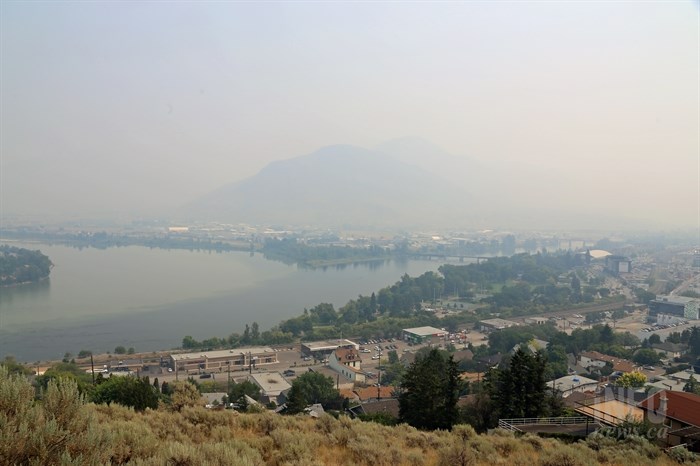
FILE PHOTO - Heavy smoke from wildfires can be seen over Kamloops in this undated file photo. People living within in a 50-kilometre radius of wildfires in the last 10 years have an higher chance of developing brain tumours and lung cancer, according to a new study.
(JENNIFER STAHN / iNFOnews.ca)
May 13, 2022 - 12:30 PM
People living within in a 50-kilometre radius of wildfires in the last 10 years have an higher chance of developing brain tumours and lung cancer, according to a new study.
The study from McGill University tracked more than two million Canadians in a period of 20 years and is the first to examine how proximity to forest fires may influence cancer risk, according to a press release from the university.
“Wildfires tend to happen in the same locations each year, but we know very little about the long-term health effects of these events. Our study shows that living in close proximity to wildfires may increase the risk of certain cancers,” says Scott Weichenthal, an epidemiology professor at McGill University, in the press release.
READ MORE: B.C. Wildfire Service 'carefully monitoring' Kamloops, Kelowna areas this month
The study was recently published in The Lancet Planetary Health and shows people living within 50 km of wildfires in the past 10 years had a 10% higher incidence of brain tumors and 4.9% higher incidence of lung cancer, compared to people living further away.
“Many of the pollutants emitted by wildfires are known human carcinogens, suggesting that exposure could increase cancer risk in humans,” says Jill Korsiak, a PhD student in Professor Weichenthal’s lab who led the analysis in the release.
Wildfires typically occur in similar regions each year and as a result, people living in nearby communities might be exposed to carcinogenic wildfire pollutants on a chronic basis, according to the researchers.
READ MORE: Thompson Nicola directors frustrated with lack of answers from B.C. Wildfire Service over massive 2021 fire
In addition to impacts on air quality, wildfires also pollute aquatic, soil, and indoor environments. While some pollutants return to normal concentrations shortly after the fire has stopped burning, other chemicals might persist in the environment for long periods of time, including heavy metals and hydrocarbons, according to the study.
“Exposure to harmful environmental pollutants might continue beyond the period of active burning through several routes of exposure,” Weichenthal says.
More research is necessary to understand the complex mixture of environmental pollutants released during wildfires, according to the researchers. They also note further work is needed to develop more long-term estimates of the chronic health effects of wildfires.
READ MORE: Cattle helping to manage B.C. wildfire risk with targeted grazing
To contact a reporter for this story, email Carli Berry or call 250-864-7494 or email the editor. You can also submit photos, videos or news tips to the newsroom and be entered to win a monthly prize draw.
We welcome your comments and opinions on our stories but play nice. We won't censor or delete comments unless they contain off-topic statements or links, unnecessary vulgarity, false facts, spam or obviously fake profiles. If you have any concerns about what you see in comments, email the editor in the link above.
News from © iNFOnews, 2022